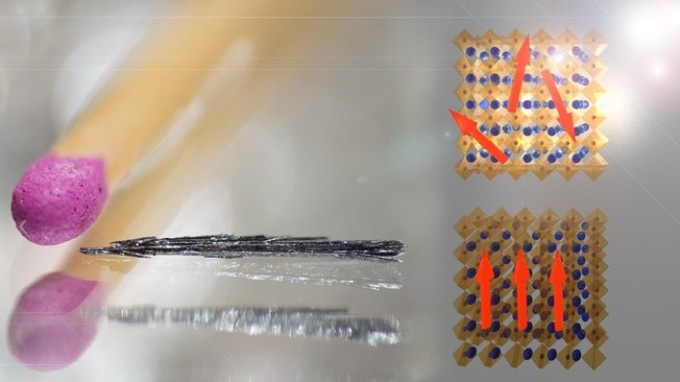Nov 25 2016
Everyday tons of data is generated, which requires storage systems such as hard drives with a higher efficiency and density. This also requires materials whose magnetic properties can be swiftly and easily controlled in order to write and access data on them.
 Single crystals of the perovskite developed in this study; on the right a diagram showing the melting of the ferromagnetic state © M. Spina, E. Horváth/EPFL
Single crystals of the perovskite developed in this study; on the right a diagram showing the melting of the ferromagnetic state © M. Spina, E. Horváth/EPFL
Researchers at EPFL have recently created a perovskite material whose magnetic order can be quickly modified without disturbing it due to heating. The research has been published in Nature Communications and it describes the first ever magnetic photoconductor.
The lab of László Forró at EPFL synthesized a ferromagnetic photovoltaic material. Perovskite photovoltaics are gradually becoming a cheaper substitute to existing silicon systems, attracting a lot of interest from energy scientists. But this particular material, which is a tailored version of perovskite, displays certain unique properties that make it especially interesting as a material to build next-generation digital storage systems. This project effort was led by postdoc Bálint Náfrádi.
Magnetism in material is caused by the interactions of moving and localized electrons of the material; simply put, it is due to a competition between different movements of electrons. This means that the ensuing magnetic state is wired in the material and it cannot be overturned without altering the structure of electrons in the material’s crystal structure or chemistry. In a simpler way to alter magnetic properties would be a huge advantage in several applications such as magnetic data storage.
The new material developed by the EPFL researchers offers precisely that. “We have essentially discovered the first magnetic photoconductor,” says Bálint Náfrádi. This new crystal structure integrates the benefits of both ferromagnets, whose magnetic moments are arranged in a well-defined order, and photoconductors, where light illumination produces high density free conduction electrons.
The blend of the two properties created a totally new phenomenon: the “melting" of magnetization by photo-electrons, which are electrons that are discharged from a material when light touches it. In the new perovskite material, a simple red LED — a lot weaker than a laser pointer — is sufficient to disturb, or “melt” the magnetic order of the material and produce a high density of moving electrons, which can be freely and endlessly tuned by modifying the intensity of light. The timescale for shifting the magnetic order in this material is also very quick, almost needing just quadrillionths of a second.
Although still in experimental phase, all these properties indicate that the new material can be used to develop the next generation of memory-storage systems, possessing higher capacities with low energy requirements. “This study provides the basis for the development of a new generation of magneto-optical data storage devices,” says Náfrádi. “These would combine the advantages of magnetic storage — long-term stability, high data density, non-volatile operation and re-writability— with the speed of optical writing and reading.”
This research included contributions from the European Synchrotron Radiation Facility and the University of Geneva. It received funding from the Swiss National Science Foundation, the European Research Council (PICOPROP and TopoMat) and the NCCR-MARVEL.
Reference
B. Náfrádi, P. Szirmai, M. Spina, H. Lee, O. V. Yazyev, A. Arakcheeva, D. Chernyshov, M. Gibert, L. Forró, E. Horváth. Optically switched magnetism in photovoltaic perovskite CH3NH3(Mn:Pb)I3.Nature Communications 24 November 2016. DOI: 10.1038/ncomms13406